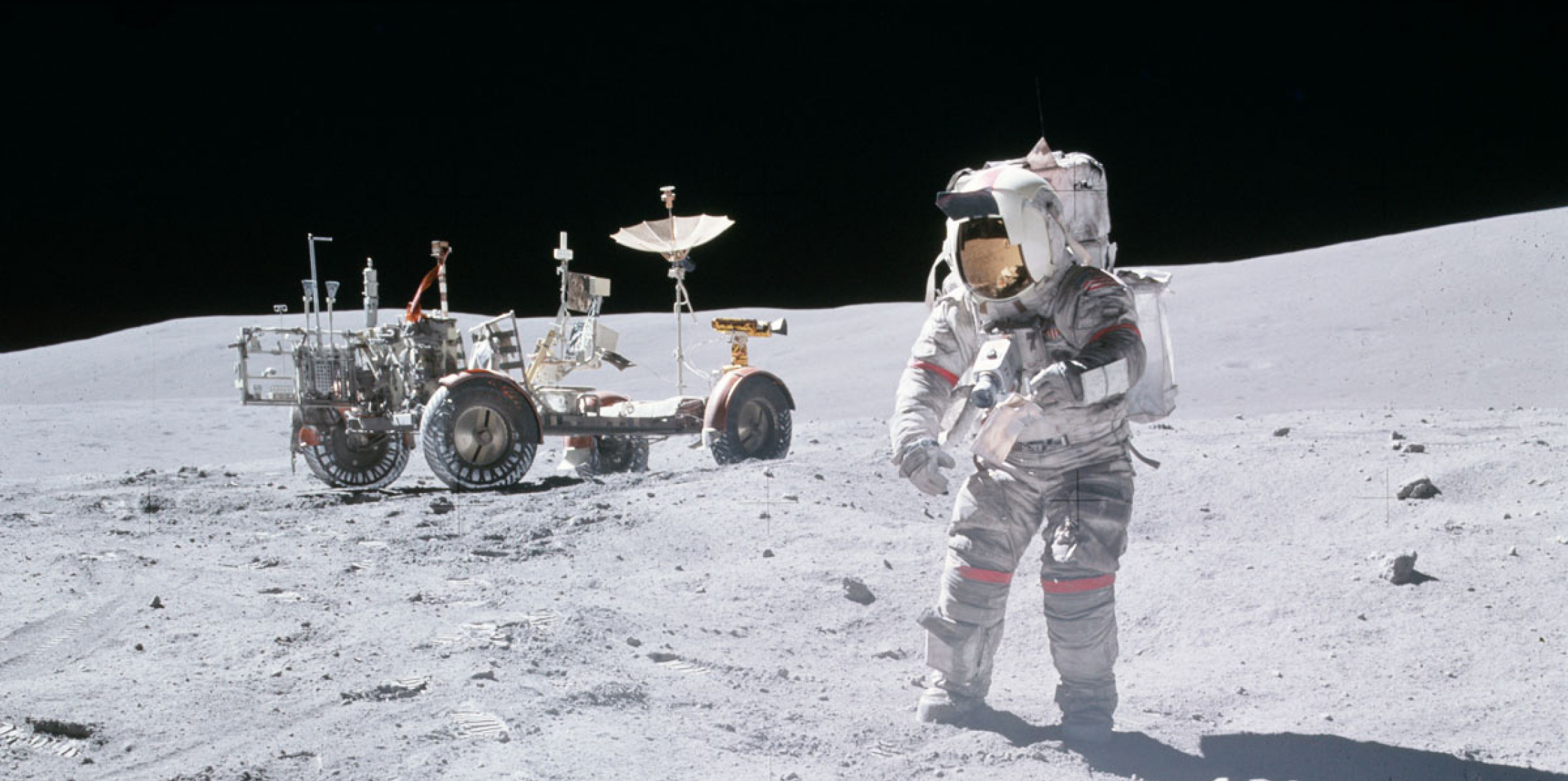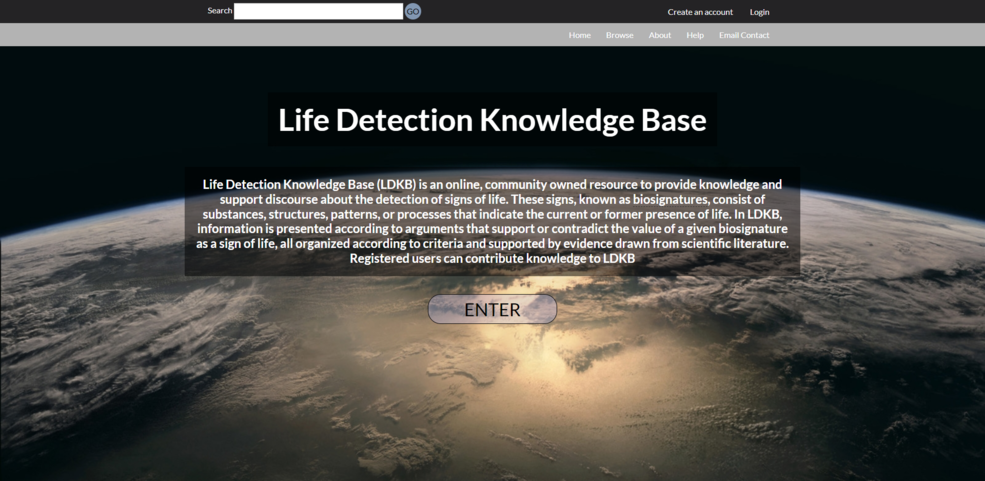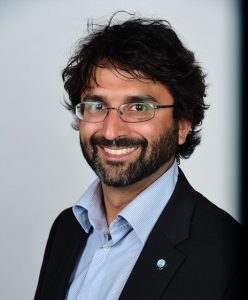Center for Life Detection (CLD) – Research and Service
Overview
The search for life elsewhere is among NASA and SMD’s high level priorities (Science 2020-2024: A Vision for Scientific Excellence, Priority 1). The Center for Life Detection is designed to support the planning and implementation of missions that will seek evidence of life beyond Earth by:
- conducting research on “detectability” to help inform target/sample selection and measurement strategies/requirements;
- developing tools and engagement activities that enable members of the broader astrobiology to formulate their knowledge, research, and expertise in a way that facilitates use in mission planning;
- supporting the instrument development community in mapping existing and emerging measurement technology to life detection science objectives, in order to establish science traceability and identify technology development needs.
CLD’s perspectives on life detection science and technology development are summarized in “Groundwork for Life Detection”, a white paper submitted to the 2023-2032 Planetary Science and Astrobiology Decadal Survey.
The Center for Life Detection is supported by NASA’s Planetary Science Division.
Research
The last few decades of exploration have revealed multiple worlds within and beyond our solar system that are considered potentially habitable by virtue of the presence of liquid water, and mission concepts to seek evidence of life on these worlds are being developed. To inform these concepts, it is essential to assess detectability – the extent to which life, if present, would express itself in characteristic, observable features. As Earth vividly illustrates, the abundance distribution of life and its products ranges over many orders of magnitude, as a function of multiple environmental and ecological factors. Similar variability can be expected both within and among inhabited worlds beyond Earth, if any exist, and understanding it can inform target selection, observing strategies, and measurement requirements for missions that seek evidence of life. The objective of CLD research is to develop a framework that constrains detectability as a function of spacecraft and/or telescope observables, with applications to Mars, ocean worlds, and exoplanets.
In this research, we investigate the role of environmental factors in modulating biological potential – the abundance and productivity of life, including the production of diagnostic features, that could be supported in a given system, and biosignature potential, the extent to which a given system will express observable evidence of life based on preservation, degradation, or modification of biologically produced materials. We combine insights and methodology from these complementary lines of investigation to assess biological and biosignature potential in ancient Mars surface environments as constrained by in situ mineralogy data from the Mars Science Laboratory mission.
This research is responsive to a recommendation in the National Academies Consensus Report on Astrobiology Strategy (NASEM ABS): “Detectability: NASA should support expanding biosignature research to address gaps in understanding biosignature preservation and the breadth of possible false positives and false negative signatures”.
The Life Detection Forum Project
The astrobiology knowledge that will be required for life detection mission concept development and science definition is diverse, often taking forms that do not map clearly to mission design, and diffuse, in that it is spread across many disciplines and a wide-ranging literature. The Life Detection Forum (LDF) project seeks to develop a ‘living’, community-driven suite of tools to centralize the requisite body of knowledge and organize it in a way that streamlines its use in program planning, mission concept development, and interpretation of findings. CLD works actively to engage a diverse range of communities in the use of this tool, to harness valuable expertise that is not well represented in the traditional sphere of space science.
The LDF is being built as a web-based platform that can be populated and continually updated by a broad user base, in order to track the evolving state of knowledge regarding life detection science and technology. The core module of the system, released in early 2021, is the Life Detection Knowledge Base (LDKB).
LDKB is a system for organizing user-provided knowledge about objects, patterns, or processes that might serve as evidence for life according to its bearing on the potential for false positive or false negative results. A technology-oriented counterpart to LDKB, the Measurement Technology Module (MTM) is currently in development. MTM is designed to house user-contributed information regarding current and emerging technologies that could be used to support life detection objectives. When combined, LDKB and MTM will provide a basis for establishing science traceability and identifying technology development needs.
This effort is responsive to the NASEM ABS recommendation: “NASA should aid the community in developing a comprehensive framework…to guide testing and evaluation of in situ and remote biosignatures.”
screencapture-ldfknowledgebase-2022-02-14-11_34_07_1.png
CLD-led Workshops
CLD has sought extensive community involvement in the development of LDF tools and early stages of LDKB content development, through a series of workshops and hands-on community engagement activities.
Introduction to the Life Detection Forum Project (AbSciCon 2019)
- Special session, approx. 130 participants
- Introduction to, and feedback on, the LDF concept and a basic working model
Criteria for Life Detection Measurements (Fall 2020)
- Two community workshops, 60+ participants
- Establish/vet the evaluative organizing basis for LDKB
The Life Detection Knowledge Base (January 2021)
- Rollout of LDKB at a community workshop of > 150 participants
LDKB Content Development Groups (Spring-Fall 2021)
- CLD-facilitated, community-based user groups (100+ participants, active 6-8 months)
- Content provision in 5 theme areas, beta testing of LDKB, build & train user base
Life Detection Science and Technology Workshop (Spring 2022)
- Bring together scientists and technologists to discuss high-priority approaches to life-detection, define measurement requirements, and identify corresponding measurement technology gaps
Team Members
CLD is a collaboration among scientists and technologists from NASA’s Ames Research Center and Goddard Space Flight Center:
Affiliation: Solar System Exploration Division at Goddard Space Flight Center
william.b.brinckerhoff(at)nasa.gov
Title: Senior Scientist
Tom Bristow
Branch: Exobiology
Thomas.F.Bristow(at)nasa.gov
Title: Staff Scientist
Affiliation: Space Biosciences Research Branch
jared.t.broddrick(at)nasa.gov
Title: Scientist
Branch: Exobiology
Title: Research Scientist
alfonso.davila(at)nasa.gov
Branch: Exobiology
David.J.DesMarais(at)nasa.gov
Title: Principal Investigator
Affiliation: Goddard Space Flight Center
jennifer.l.eigenbrode(at)nasa.gov
Title: Interdisciplinary Astrobiologist
Richard (Craig) Everroad
Branch: Exobiology
Craig.Everroad(at)nasa.gov
Title: Research Scientist
Affiliation: Goddard Space Flight Center
stephanie.a.getty(at)nasa.gov
Title: Planetary Research Scientist
Affiliation: Goddard Space Flight Center
daniel.p.glavin(at)nasa.gov
Title: Space Scientist
Branch: Exobiology
Tori.M.Hoehler(at)nasa.gov
Title: Research Scientist
Branch: Exobiology
linda.l.jahnke(at)nasa.gov
Title: Senior Scientist
Melissa Kirven-Brooks
Branch: Exobiology
melissa.kirven-brooks(at)nasa.gov
Title: Deputy Branch Chief
Michael Kubo
Branch: Exobiology – Coop/SETI
Michael.D.Kubo(at)nasa.gov
Title: Research Scientist/ Lab Manager
Barbara Lafuente-Valverde
Branch: Exobiology – SETI Institute
barbara.lafuentevalverde(at)nasa.gov
Title: Research Scientist
Affiliation: Blue Marble Space
grahamlau(at)bmsis.org
Title: Research Investigator
Owen Lehmer
Branch: Exobiology – University of Washington
Title: Research Scientist
owen.r.lehmer(at)nasa.gov
Affiliation: Goddard Space Flight Center
marc.f.neveu(at)nasa.gov
Title: Research Scientist
Niki Parenteau
Branch: Exobiology
Other Affiliation: Research Scientist
Mary.N.Parenteau(at)nasa.gov
Branch: Exobiology
Andrzej.Pohorille-1(at)nasa.gov
Title: Principal Investigator
Richard Quinn
Branch: Exobiology
Other Affiliation: Research Scientist
Richard.C.Quinn(at)nasa.gov
Affiliation: Stanford University
tony.ricco(at)nasa.gov
Title: Chief Technologist
Andro Rios
Branch: Exobiology – Blue Marble Space Institute of Science
Andro.C.Rios(at)nasa.gov
Title: Research Scientist
Affiliation: Goddard Space Flight Center
svetlana.shkolyar(at)nasa.gov
Title: Research Scientist
Branch: Exobiology – Coop/Blue Marble Space
Title: Scientist / Engineer










































